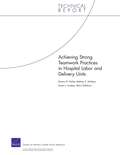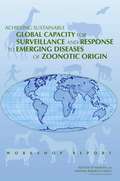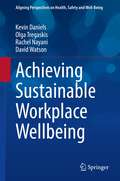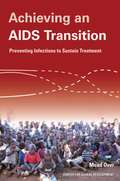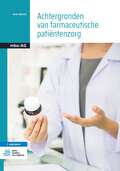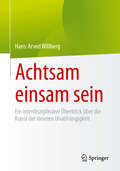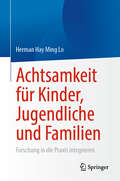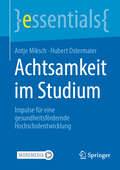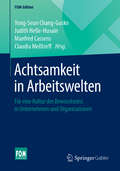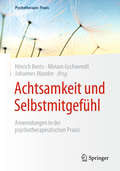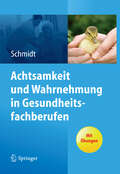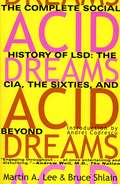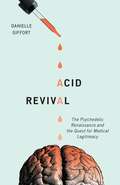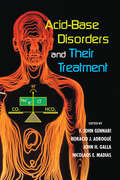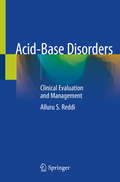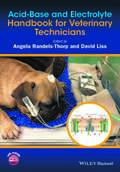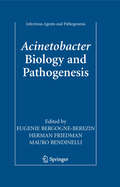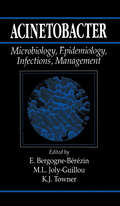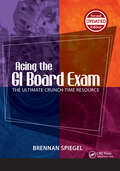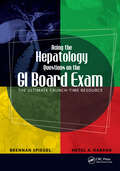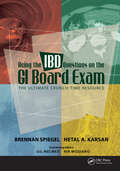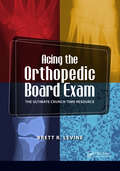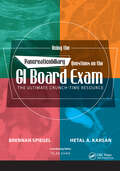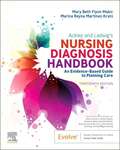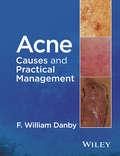- Table View
- List View
Achieving Strong Teamwork Practices in Hospital Labor and Delivery Units
by Donna O. Farley Susan L. Lovejoy Mary Salisbury Melony E. SorberoTo learn how hospital labor and delivery units can achieve effective and sustainable teamwork practices and how much such practices affect staff experiences and patient outcomes, RAND researchers studied five units as they implemented improvements in their teamwork practices over a one-year period. They identified some key factors required by any given strategy for teamwork improvement but no standard template for implementation.
Achieving Sustainable Global Capacity For Surveillance And Response To Emerging Diseases Of Zoonotic Origin: Workshop Report
by Institute of Medicine National Research Council of the National AcademiesOne of the biggest threats today is the uncertainty surrounding the emergence of a novel pathogen or the re-emergence of a known infectious disease that might result in disease outbreaks with great losses of human life and immense global economic consequences. Over the past six decades, most of the emerging infectious disease events in humans have been caused by zoonotic pathogens--those infectious agents that are transmitted from animals to humans. In June 2008, the Institute of Medicine's and National Research Council's Committee on Achieving Sustainable Global Capacity for Surveillance and Response to Emerging Diseases of Zoonotic Origin convened a workshop. This workshop addressed the reasons for the transmission of zoonotic disease and explored the current global capacity for zoonotic disease surveillance.
Achieving Sustainable Workplace Wellbeing (Aligning Perspectives On Health, Safety And Well-being Ser.)
by David Watson Kevin Daniels Olga Tregaskis Rachel NayaniIn this groundbreaking interdisciplinary work, the authors focus on organizational analysis to understand workplace wellbeing, deviating from previous research that mostly looks at the individual worker or intervention. In addressing the question of why workplace health and wellbeing practices initiatives fall short of delivering sustained improvements in worker wellbeing, this book moves beyond localized explanations of the failure of specific interventions. Instead, it creates theoretical frameworks that explain how wellbeing at work can be improved and sustained. The authors use evidence from systematic and comprehensive surveys of the literature as well as new empirical research, and present an explanatory framework of the processes through which organizations change to implement and accommodate workplace health and wellbeing practices. Learning, adaptation and continuation explain successful implementation of workplace health and wellbeing practices, while Gestalting, fracturing and grafting explain how organizations resolve or negotiate conflict between health and wellbeing practices and existing organizational procedures, systems and practices. In addition, the authors reflect on the implications for research of reframing the unit of analysis as the organization and how studies on workplace wellbeing practices can provide a conceptual platform for thinking about the way organizations can create social value in a broader sense. This book, authored by experts in their field, is a great resource for academics and professionals of organizational studies and of worker wellbeing across the social sciences, behavioural sciences, business and management courses, wellbeing research, and labour studies.
Achieving an AIDS Transition
by Mead OverFive million people in poor countries are receiving AIDS treatment, but international AIDS policy is still in crisis. Donors are giving less than they had been, even though infections continue unabated, and the number of people dependent on treatment rises each year.This book proposes a feasible medium-term objective for AIDS policy: achieving an "AIDS transition," that is, keeping AIDS deaths down by sustaining treatment while pushing new infections even lower, so that the total number of people living with HIV/AIDS begins to decline. How? Through a new, incentive-driven strategy to improve HIV prevention and a sustained effort to get the most from AIDS treatment.
Achtergronden van farmaceutische patiëntenzorg (Basiswerk AG)
by Jeroen MentinkDit boek gaat in op het leveren van farmaceutische patiëntenzorg. Om deze zorg goed te kunnen leveren is het noodzakelijk meer te weten over onderwerpen die daar een belangrijke rol bij spelen: denk aan medicatieveiligheid, het goed uitvoeren van medicatiebewaking, polyfarmacie, de invloed van therapietrouw en de samenwerking tussen de verschillende zorgverleners, zoals de huisarts, de praktijkondersteuner, de thuiszorg, de specialisten in het ziekenhuis en andere apotheken. In het boek is ook aandacht voor de rol van de mantelzorger, de zorg aan de patiënt die niet meer beter wordt (palliatieve zorg) en de kwaliteit van zorg die elke apotheek moet leveren.Achtergronden van farmaceutische patiëntenzorg is een geheel nieuw boek. Het heeft zijn eigen plek gekregen naast het standaardwerk Farmacotherapie voor apothekersassistenten. Het boek sluit door de inhoud naadloos aan op de onderdelen B1-K1 ‘Voert geïndividualiseerde farmaceutische patiëntenzorg uit’, B1-K1 ‘Verleent niet-receptgestuurde zorg aan de patiënt’ en B1-K4-W3 ‘Werkt multidisciplinair samen en stemt werkzaamheden af (samenwerking)’ uit het Kwalificatiedossier. Daarnaast is het boek bij uitstek geschikt om ingezet te worden bij het keuzedeel ‘Specifieke doelgroepen voor de apothekersassistent’. In Nederland is het begrip ‘farmaceutische patiëntenzorg (FPZ)’ in 1993 geïntroduceerd. Bij farmaceutische patiëntenzorg vindt een intensievere begeleiding van patiënten plaats door de apotheek. Het doel is dat de patiënt zijn geneesmiddelen zo effectief, correct en veilig mogelijk gebruikt. Dit kan alleen als het apotheekteam de patiënt goed kan informeren over de geneesmiddelen, de toediening en het doel of belang van de behandeling. Farmaceutische patiëntenzorg wordt geleverd door het hele apotheekteam. Achtergronden van farmaceutische patiëntenzorg is geschikt voor iedereen die de opleiding tot apothekersassistent volgt. Daarnaast is het als naslagwerk erg handig in de dagelijkse praktijk van de apotheek.Jeroen Mentink is openbaar apotheker in Zierikzee. Naast zijn werkzaamheden als apotheker is hij actief in het onderwijs en heeft hij ruime ervaring met (na)scholing van apothekers, farmaceutisch consulenten en apothekersassistenten. Verder heeft hij zitting in diverse (vakinhoudelijke) commissies en is hij actief als auteur van scholingen en naslagwerken.
Achtsam einsam sein: Ein interdisziplinärer Überblick über die Kunst der inneren Unabhängigkeit
by Hans-Arved WillbergIn diesem populären Fachbuch werden die Chancen des Alleinseins und der Einsamkeit für die persönliche Entwicklung und die eigene psychische Gesundheit aufgezeigt. Denn Einsamkeit ist nicht dasselbe wie Vereinsamung. Vereinsamung schwächt die psychophysische Konstitution und kann krank machen. Aber Einsamkeit kann auch die Gesundheit stärken. Einsamkeit gehört zu den notwendigen menschlichen Reifungserfahrungen und birgt Quellen für Kreativität. Dieses Buch differenziert die gesunde Einsamkeit von der kränkenden und krank machenden Einsamkeit. Erkenntnisse aus Psychologie und Sozialwissenschaften geben einen interdisziplinären Überblick über die Phänomene Einsamkeit und Vereinsamung, beschreiben das menschliche Bedürfnis nach Nähe und Distanz, konzentrieren sich aber darauf, welche Ressourcen im Alleinsein liegen: Wie komme ich zu mir selbst? Und wie bleibe ich dort, wenn ständig Eindrücke weiterer Menschen auf mich einwirken? Wie bewahre ich meine eigene Würde? Wie finde ich durch bewusste Distanz und Achtsamkeit zu mehr persönlicher Kreativität? Dieses Buch für Fachpersonen aus Psychologie, Psychotherapie, Beratung und Pädagogik macht Mut, sich die Quellen gesunder Einsamkeit zu erschließen und gibt Hinweise darauf, wie das geschehen kann.
Achtsamkeit für Kinder, Jugendliche und Familien: Forschung in die Praxis integrieren
by Herman Hay LoDieses Buch analysiert achtsamkeitsbasierte Programme für Kinder und Jugendliche mit unterschiedlichen Bedürfnissen sowie deren Eltern und anderen Familienmitgliedern. Es zeigt auf, wie ein Achtsamkeitsansatz bei dieser spezifischen Bevölkerungsgruppe angewendet wurde. Dazu beleuchtet es diverse Theorien und Evidenzen in diesem wachsenden Interessengebiet und berücksichtigt Anpassungen an Kinder und Jugendliche mit unterschiedlichen Diagnosen und deren Familiensituation. Es zeigt achtsames Elternsein in Bezug auf die Entwicklungsbedürfnisse von Kindern, relevante Implementierungsfragen im Alltag sowie die erforderlichen Kompetenzen von Achtsamkeitslehrern auf. Wichtige Themen in Kürze: Anwendung achtsamkeitsbasierter Programme zur Bewältigung der Entwicklungsaufgaben – unter Berücksichtigung der unterschiedlichen Bedürfnisse von Kindern und Jugendlichen sowie der Herausforderungen im Bereich der psychischen Gesundheit und sozialen Betreuung. Achtsamkeitsbasierte Programme für Eltern und Lehrer und deren Auswirkungen auf Kinder. Implementierung der wissenschaftlichen und ethischen Erkenntnisse von Achtsamkeitsschulung in den verschiedenen Entwicklungsphasen von Kindern. Achtsamkeit für Kinder, Jugendliche und Familien ist eine wichtige Ressource für Forscher, Professoren und Doktoranden sowie für Kliniker, Therapeuten und verwandte Fachkräfte in der Entwicklungspsychologie, Schulpsychologie, Kinder- und Jugendpsychologie, Sozialarbeit, Public Health, Pädiatrie, komplementärer und alternativer Medizin sowie in allen verwandten Disziplinen.
Achtsamkeit im Studium: Impulse für eine gesundheitsfördernde Hochschulentwicklung (essentials)
by Antje Miksch Hubert OstermaierAchtsamkeit leistet einen wesentlichen Beitrag dazu, dass Gesundheitsförderung gelingt. Dies gilt für einzelne Menschen, wie auch für Organisationen. In diesem Essential wird dargestellt, welches Potenzial Achtsamkeit und damit verbunden die Kultivierung von Präsenz und Mitgefühl in Hochschulen entfalten kann. Gelingende Lernprozesse im Studium brauchen eine Persönlichkeitsentwicklung, die das Wohlbefinden von Studierenden und die Entwicklung von Gestaltungskompetenz fördert. Lehrende haben hierbei als Multiplikatoren eine Schlüsselfunktion. Im Buch werden die Zusammenhänge zu einer gesundheitsfördernden Hochschulentwicklung und die Wirkung weit über das Studium und die Hochschule hinaus aufgezeigt. Es richtet sich an Lehrende, Studierende und Führungskräfte an Hochschulen sowie Verantwortliche für Personalentwicklung und Gesundheitsmanagement in allen Organisationen.
Achtsamkeit in Arbeitswelten: Für eine Kultur des Bewusstseins in Unternehmen und Organisationen (FOM-Edition)
by Yong-Seun Chang-Gusko Judith Heße-Husain Manfred Cassens Claudia Meßtorff„Achtsamkeit“ ist ein im Gesundheitsbereich zunehmend beachtetes Thema. Etliche Unternehmen richten Achtsamkeitsseminare für ihre Mitarbeiterinnen und Mitarbeiter mit dem Ziel aus, die Gesundheit und Zufriedenheit der Belegschaft zu stärken, Produktivitätsverluste zu vermeiden und ihre Attraktivität als Arbeitgeber vor dem Hintergrund des demografischen Wandels zu stärken. Doch was genau ist unter Achtsamkeit zu verstehen und in welche Arbeitswelten hat sie Einlass gefunden? Und welche wissenschaftlichen Erkenntnisse zur Achtsamkeit liegen vor?Diesen und weiteren Fragen gehen die Autorinnen und Autoren in diesem Buch nach: Sie informieren zunächst über die Geschichte der Achtsamkeit und fassen Ergebnisse aus der Grundlagenforschung zu psychobiologischen Korrelaten der Achtsamkeit zusammen. Anschließend werden Herausforderungen, Bedarfe und bestehende Ansätze der Achtsamkeitsförderung in ausgewählten Arbeitswelten des Gesundheits- und Sozialwesens, der Verwaltung und Bildung sowie der Wirtschaft vorgestellt. In einem abschließenden Beitrag zur Evaluation eines achtsamkeitsbasierten Führungsprogramms werden Wege aufgezeigt, wie in Unternehmenskontexten eine wissenschaftlich qualitative Evaluationsstudie durchgeführt werden kann.Eine gelungene Verbindung von Grundlagenwissen und Praxisbezug, die Leser aus Wissenschaft und Praxis anspricht.
Achtsamkeit und Selbstmitgefühl: Anwendungen in der psychotherapeutischen Praxis (Psychotherapie: Praxis)
by Hinrich Bents Miriam Gschwendt Johannes ManderDieses Buch gibt einen Überblick über Konzepte und Praxis von Achtsamkeit und Selbstmitgefühl in der Psychotherapie, stellt störungsspezifische Anwendungen in der Erwachsenenpsychotherapie und in der Kinder- und Jugendlichenpsychotherapie vor und skizziert Entwicklungen in unterschiedlichen Settings (von Paartherapie bis Onlinetherapie). Achtsamkeit und Selbstmitgefühl sind Prinzipien mit einer weit zurückreichenden Geschichte. Diese Traditionen erleben im psychosozialen Bereich eine Renaissance – vielleicht als sinnstiftendes Gegengewicht zu den unüberschaubar gewordenen komplexen Anforderungen einer multipel vernetzten Welt. Auch in die moderne, wissenschaftlich fundierte Psychotherapie haben Achtsamkeitskonzepte als theoretische Grundlage wie auch in praktischen Anwendungen Eingang gefunden. Geschrieben für … Psychologische und Ärztliche Psychotherapeuten, Kinder- und Jugendlichenpsychotherapeuten, Psychiater, Ärzte aller Fachrichtungen, psychosoziale Berufe in Kliniken, Beratungsstellen und anderen komplementären Einrichtungen, Psychotherapeuten in der Ausbildung. Die Herausgeber: Dr. Hinrich Bents – Psychologischer Psychotherapeut, Geschäftsführender Direktor des Zentrums für Psychologische Psychotherapie der Universität Heidelberg (ZPP Heidelberg). Dr. Miriam Gschwendt – Psychologische Psychotherapeutin, Praxengemeinschaft Psychotherapie im Mathematikon, Heidelberg. Priv.-Doz. Dr. Johannes Mander – Psychologischer Psychotherapeut, stellvertretende Studienleitung und Psychotherapieforschung am ZPP Heidelberg.
Achtsamkeit und Wahrnehmung in Gesundheitsfachberufen
by Simone SchmidtIn diesem ersten Buch zur Achtsamkeit für Gesundheitsfachberufe werden Lösungsmöglichkeiten für alltägliche Stresssituationen angeboten, die die soziale Wahrnehmung im Umgang mit Patienten, Angehörigen und Kollegen gezielt schulen. Diese Techniken werden anhand von Praxisbeispielen erläutert, so dass Leser diese schnell erlernen und umsetzen können. Geeignet ist das Buch außerdem für Leiter von Fortbildungen oder Teamsitzungen, die die Achtung der Mitarbeiter vor dem Gegenüber aber auch vor sich selbst, verbessern möchten.
Acid Dreams: The CIA, the Sixties, and Beyond
by Martin A. Lee Bruce ShlainMartin Lee and Bruce Shlain's exhaustively researched and astonishing account -- part of it gleaned from secret government files -- tells how the CIA became obsessed with LSD as an espionage weapon during the early l950s and launched a massive covert research program, in which countless unwitting citizens were used as guinea pigs. Though the CIA was intent on keeping the drug to itself, it ultimately couldn't prevent it from spreading into the popular culture; here LSD had a profound impact and helped spawn a political and social upheaval that changed the face of America.
Acid Revival: The Psychedelic Renaissance and the Quest for Medical Legitimacy
by Danielle GiffortA vivid analysis of the history and revival of clinical psychedelic science Psychedelic drugs are making a comeback. In the mid-twentieth century, scientists actively studied the potential of drugs like LSD and psilocybin for treating mental health problems. After a decades-long hiatus, researchers are once again testing how effective these drugs are in relieving symptoms for a wide variety of psychiatric conditions, from depression and obsessive–compulsive disorder to posttraumatic stress disorder and substance addiction. In Acid Revival, Danielle Giffort examines how this new generation of researchers and their allies are working to rehabilitate psychedelic drugs and to usher in a new era of psychedelic medicine. As this team of researchers and mental health professionals revive the field of psychedelic science, they are haunted by the past and by one person in particular: psychedelic evangelist Timothy Leary. Drawing on extensive archival research and interviews with people working on scientific psychedelia, Giffort shows how today&’s researchers tell stories about Leary as an &“impure&” scientist and perform his antithesis to address a series of lingering dilemmas that threaten to rupture their budding legitimacy. Acid Revival presents new information about the so-called psychedelic renaissance and highlights the cultural work involved with the reassembly of dormant areas of medical science. This colorful and accessible history of the rise, fall, and reemergence of psychedelic medicine is infused with intriguing narratives and personalities—a story for popular science aficionados as well as for scholars of the history of science and medicine.
Acid-Base Disorders and Their Treatment
by F. John GennariWith detailed contributions and research from experts in the physiology of normal acid-base homeostasis and the management of acid-base disorders, this reference supplies an abundance of information on acid-base physiology, disorders of acid-base equilibrium, and the management and treatment of these disorders in clinical practice. A unique and tim
Acid-Base Disorders: Clinical Evaluation and Management
by Alluru S. ReddiThis book provides a concise yet comprehensive overview of acid-base disorders. Each chapter reviews an acid-base disorder, covering pathophysiology, evaluation, and management of the disorder. The chapters also include clinical cases and a Q&A section, based on scenarios and questions that clinicians regularly encounter when treating patients with these disorders. The book concludes with two chapters on acid-based disorders in special patient populations, including critically ill patients, pregnant patients, and surgical patients. Written by an expert in the field, Acid-Base Disorders: Clinical Evaluation and Management is a state-of-the-art resource that should assist clinicians and practitioners in managing patients with acid-base disorders.
Acid-Base and Electrolyte Handbook for Veterinary Technicians
by David Liss Angela Randels-ThorpAcid-Base and Electrolyte Handbook for Veterinary Technicians provides an easy to understand yet comprehensive approach to acid-base and electrolyte balance. Covers the physiology of fluids and their effect on acid-base and electrolyte balance Offers detailed information on managing acid-base and electrolyte derangements in disease Includes access to a companion website with case studies and multiple choice questions
Acinetobacter: Biology and Pathogenesis (Infectious Agents and Pathogenesis)
by Eugénie Bergogne-Bérézin Mauro Bendinelli Herman FriedmanThere is currently increasing interest concerning the biology and disease caused by Acinetobacter species. Such interest, however, developed relatively slowly because of the necessity to clarify the confusing taxonomy of these organisms. Much work was needed to identify various species as members of this genus, to recognize their epidemiologic profile, their pathogenic role and their increasing importance as multi-antibiotic resistant organisms. In recent years improvement of genetic approaches, recognition of plasmids, integrons and chromosomal sources of resistance mechanisms aroused interest on the role of Acinetobacters in disease by many microbiologists and clinicians, especially internists and infectious disease specialists. In this regard, physicians are frequently confronted with extremely difficult therapeutic approaches for treatment and prevention of severe nosocomial infections due to multi antibiotic resistant Acinetobacter. Moreover, recent observations of community acquired infections have been reported, especially in patients with various risk factors such as immuno-deficiencies. Also, it is now becoming evident that Acinetobacter infections occur frequently in violent situations such as earthquake or war zones. The mechanisms of Acinetobacter virulence are becoming increasingly clear, providing new insights into their pathogenic role in community acquired infections. It is apparent the time is appropriate for detailed review of the increasing knowledge concerning important new information, both clinical and therapeutic, especially information concerning virulence, resistance mechanisms and typing of Acinetobacter spp. Many new findings are accumulating in almost an exponential manner since publication of previous books on this subject in 1991 and 1996.
Acinetobacter: Microbiology, Epidemiology, Infections, Management
by E. Bergogne-Berezin Marie-Laure Joly-Guillou Kevin J. TownerAcinetobacter details the clinical aspects of this bacterium responsible for many infections in hospitalized patients. This reference explains the importance of these organisms, both from the patient's viewpoint and the economic perspective, and provides clinicians with the knowledge they need to control these bacteria.
Acing the GI Board Exam: The Ultimate Crunch-Time Resource
by Brennan SpiegelAcing the GI Board Exam: The Ultimate Crunch-Time Resource has been updated into a Second Edition. The Second Edition contains new vignettes, a discussion on Maintenance of Certification (MOC) Exam, and discussion on test relevancy for residency rotations! In today’s fast-paced world, gastroenterology and hepatology residents and fellows struggle to find the time to study for the board exams, prepare for the recertification exam, prepare for teaching rounds, or just plain read. What is the best way to effectively prepare and study, if reading multiple resources can’t seem to fit into your daily schedule? The answer to your study questions (and study time!) can be found inside the newly updated Second Edition of Acing the GI Board Exam: The Ultimate Crunch-Time Resource! Why You Will Need to Read Acing the GI Board Exam, Second Edition: New! 41 new and carefully vetted board-style vignettes with color images New! Brief discussion on the Maintenance of Certification (MOC) Exam New! Discussion on test relevancy for residency rotations Comprehensive yet succinct answers using a high-yield format Emphasis on key clinical pearls and “board buzzwords” Answers to classic board “threshold values” questions that you need to know but always seem to forget Rapid-fire, crunch-time exam with 200 classic one-liners Dr. Brennan Spiegel has collected every pearl of wisdom, high-yield factlet, "Board buzzword," micrograph, and classic imaging study he could muster, all while keeping Acing the GI Board Exam: The Ultimate Crunch-Time Resource, Second Edition a manageable size. Acing the GI Board Exam, Second Edition fills the unmet need in board review by presenting time-tested and high-yield information in a rational, useful, and contextually appropriate format suitable studying for the board exams and preparing for the recertification exam.Chapters Include: A compilation of general lessons learned from past test-takers “Tough Stuff” board review vignettes Board review “Clinical Threshold Values” “Crunch-Time” Self-Test and Answer Guide—time to get your game on! With its focus on pearl after pearl, emphasis on images, and attention to high-yield “tough stuff” vignettes you don’t know the answers to (yet), Acing the GI Board Exam, Second Edition is truly the ultimate crunch-time resource for acing the GI and Hepatology examination, taking recertifying examinations, looking good on clerkship rounds, or for just challenging yourself with interesting and entertaining vignettes.
Acing the Hepatology Questions on the GI Board Exam: The Ultimate Crunch-Time Resource
by Brennan Spiegel Hetal KarsanHepatology is an expanding field - it's hard to keep up. The liver has been sitting there the whole time, but the knowledge surrounding this perplexing organ is exploding; this makes it hard to prepare for board and recertification exams, where 1 in every 4 questions pertains to hepatology. Until now, there has been no single, slim, but high-yield volume that summarises the hepatology you need to know for the boards. This book has it nailed. The authors have collected every pearl of wisdom, high-yield factlet, liver ""board buzzword,"" hepatic micrograph, and classic liver imaging study they could muster, all while keeping the book a manageable size - because who has time for more than manageable when you're busy?The answer to your study questions (and study time!) can be found inside: Acing the Hepatology Questions on the GI Board Exam: The Ultimate Crunch-Time Resource.Traditional textbooks usually feature long and detailed discussions that are not directly related to Board and recertification exams. On the flip side, many Board review manuals provide lists and bullet points lacking sufficient background and context. Inside Acing the Hepatology Questions on the GI Board Exam, Drs. Brennan Spiegel and Hetal Karsan present time-tested and high-yield information in a rational, useful, and contextually appealing format.With its focus on pearl after pearl, emphasis on images, and attention to high-yield "tough stuff" vignettes you don't know the answers to (yet), Acing the Hepatology Questions on the GI Board Exam is truly the ultimate crunch-time resource for acing often vexing liver section of the examination, taking recertifying examinations, looking good on clerkship rounds, or for just challenging yourself with interesting and entertaining vignettes.
Acing the IBD Questions on the GI Board Exam: The Ultimate Crunch-Time Resource
by Brennan Spiegel Hetal KarsanThe world of inflammatory bowel disease (IBD) knowledge is vast. Within that world is a sub-set of knowledge that is especially important for everyday clinical care. And a sub-set of that is testable for the Board exam. The testable material includes time-honored, locked-in-stone, mostly uncontroversial facts that have withstood the test of time. The answer to your study questions (and reduction of your study time!) can be found inside Acing the IBD Questions on the GI Board Exam: The Ultimate Crunch-Time ResourceUntil now, there has been no single, slim, but high-yield volume that summarizes the IBD you really need to know for the board exams, preparing for rounds, or just plain read. The authors have collected every pearl of wisdom, high-yield factlet, IBD "Board buzzword," micrograph, and classic imaging study they could muster, all while keeping Acing the IBD Questions on the GI Board Exam: The Ultimate Crunch-Time Resource a manageable size.In today’s fast-paced world it is hard to keep up with the burgeoning IBD literature. Traditional textbooks usually feature long and detailed discussions that don’t directly address board and recertification exams. On the flip side, many board review manuals provide lists and bullet points lacking sufficient background and context. Acing the IBD Questions on the GI Board Exam by Drs. Brennan Spiegel and Hetal Karsan, fills the unmet need in board review by presenting time-tested and high-yield information in a rational, useful, and contextually appropriate format.Why you need Acing the IBD Questions on the GI Board Exam:• Focuses exclusively on inflammatory bowel disease review• Carefully vetted board-style vignettes with color images• Comprehensive yet succinct answers using a high-yield format• Emphasis on key clinical pearls and “Board Buzzwords”• Rapid-fire crunch time exam with 140 classic one-liners such as:Diarrhea + mucus-filled cysts throughout colon = ?The vastly evolving world of IBD includes genetic breakthroughs and new medications with different risks and benefits. Acing the IBD Questions on the GI Board Exam has it all in one resource that includes endoscopic, histologic, radiologic and dermatologic manifestations, as well as with great images and tables to help guide the reader.Chapters include:• A compilation of general lessons learned from past test takers• “Tough Stuff” board review vignettes• “Crunch-Time” Self-Test—Time to get Your Game On! With its focus on pearl after pearl, emphasis on images, and attention to high-yield “tough stuff” vignettes you don’t know the answers to (yet), Acing the IBD Questions on the GI Board Exam: The Ultimate Crunch-Time Resource will help you ace the GI and recertifying examinations, look good on clerkship rounds, simply challenge you with interesting and entertaining vignettes, and take optimal care of your IBD patients in clinical practice.
Acing the Orthopedic Board Exam: The Ultimate Crunch Time Resource
by Brett LevineIn today’s fast-paced world, orthopedic residents and fellows struggle to find the time to study for the board exams, prepare for the recertification exam, prepare for the Orthopedic In-Training Examination, prepare for teaching rounds, or just plain read. What is the best way to effectively prepare and study, if reading multiple resources can’t seem to fit into your daily schedule? The answer to your study questions (and study time!) can be found inside, Acing the Orthopedic Board Exam: The Ultimate Crunch-Time Resource Until now, there has been no single high-yield volume that summarizes the “tough stuff” on the orthopedic board and recertification exams. Acing the Orthopedic Board Exam: The Ultimate Crunch-Time Resource is meant to give an edge on the really tough questions found on exams, rather than be a simple review of the basics. Why you need Acing the Orthopedic Board Exam: • Carefully vetted board-style vignettes with color images • Comprehensive yet succinct answers using a high-yield format • Emphasis on key clinical pearls and “Board Buzzwords”Acing the Orthopedic Board Exam by Dr. Brett R. Levine fills the unmet need in board review by presenting time-tested and high-yield information in a rational, useful, and contextually appropriate format.Chapters include: • A compilation of general lessons learned from past test takers • “Tough Stuff” board review vignettes • “Crunch-Time” Self-Test—Time to get Your Game On! With its focus on pearl after pearl, emphasis on images, and attention to high-yield “tough stuff” vignettes you don’t know the answers to (yet), Acing the Orthopedic Board Exam: The Ultimate Crunch-Time Resource will help you ace the orthopedic board and recertifying examinations, look good on clerkship rounds, simply challenge you with interesting and entertaining vignettes, and take optimal care of your patients in clinical practice.
Acing the Pancreaticobiliary Questions on the GI Board Exam: The Ultimate Crunch-Time Resource
by Brennan Spiegel Hetal KarsanThe Pancreas. It’s not very large, but it packs a punch. You gotta know about the pancreas. Then toss in the crazy complexities of the biliary system and there’s is a lot to learn to manage your patients. In this latest book in the Acing GI Board Exam Series, the focus is on the pancreas and biliary tree and how they can cause trouble. In today’s fast-paced world, it is a struggle to keep up with the burgeoning panc-bil literature. Until now, there has been no single, slim, but high-yield volume that summarizes the panc-bil you really need to know for the board exam. This review book keeps you on your toes and sharp for everyday clinical practice too. What is the best way to effectively prepare and study, if reading multiple resources can’t seem to fit into your daily schedule? The answer to your study questions (and study time!) can be found inside Acing the Pancreaticobiliary Questions on the GI Board Exam: The Ultimate Crunch-Time Resource. Dr. Brennan MR Spiegel and Dr. Hetal A. Karsan have collected every pearl of wisdom, high-yield factlet, panc-bil "board buzzword," and classic imaging study they could muster, all while keeping Acing thePancreaticobiliary Questions on the GI Board Exam a manageable size. Why You Will Need to Read Acing the Pancreaticobiliary Questions on the GI Board Exam: Carefully vetted board-style clinical vignettes with color images Comprehensive yet succinct answers using a high-yield format Emphasis on key clinical pearls and “board buzzwords” Answers to classic board “threshold values” questions that you need to know but always seem to forget Rapid-fire, crunch-time exam with 150 classic one-liners Acing thePancreaticobiliary Questions on the GI Board Exam fills the unmet need in board review by presenting time-tested and high-yield information in a rational, useful, and contextually appropriate format suitable studying for the board exams and preparing for the recertification exam. Chapters Include: A compilation of general lessons learned from past test-takers “Tough Stuff” board review vignettes Board review “Clinical Threshold Values” “Crunch-Time” Self-Test and Answer Guide—time to get your game on! With its focus on pearl after pearl, emphasis on images, and attention to high-yield “tough stuff” vignettes you don’t know the answers to (yet), Acing the Pancreaticobiliary Questions on the GI Board Exam is truly the ultimate crunch-time resource for acing the GI board examination, taking recertifying examinations, looking good on clerkship rounds, or for just challenging yourself with interesting and entertaining vignettes.
Ackley And Ladwig's Nursing Diagnosis Handbook: An Evidence-based Guide To Planning Care
by Mary Beth Flynn Makic Marina Reyna Martinez-KratzAckley and Ladwig’s Nursing Diagnosis Handbook, 13th Edition uses an easy, three-step system to guide you through client assessment, nursing diagnosis, and care planning. Step-by-step instructions show how to implement care and evaluate outcomes, and help you build skills in diagnostic reasoning and critical thinking. To make care planning easier, this handbook allows you to look up nursing diagnoses and care plans for more than 1450 client symptoms, as well as interventions from NIC (Nursing Interventions Classification) and outcomes from NOC (Nursing Outcomes Classification). Edited by noted nursing educators Mary Beth Flynn Makic and Marina Reyna Martinez-Kratz, this reference provides everything you need to write nursing care plans in just one book!
Acne
by F. William DanbyLearn to accurately diagnose, prevent and treat all three acnes using both traditional and novel approaches to understanding the causes and selecting the most effective treatments. Acne vulgaris is an extremely common condition. It is troublesome to manage, often persisting into middle age. Exact causes are becoming clear and include several hormonal stimulants, some triggered by the Western diet, and a pathogen ignored for decades. Acnes rosacea and inversa (hidradenitis suppurativa) are discussed from entirely new viewpoints.Acne: Causes and Practical Management will provide readers at all levels with a practical, well-illustrated approach to fully understanding of these disorders, a faster and more cost-effective management regimen and the rationales for their prevention. In full colour throughout and with over 200 excellent clinical images, key highlights include:Full coverage of all acne presentations - acne vulgaris, acne rosacea and acne inversaAn integrated view of the causes of the varied and overlapping acnesPreventive, novel and curative approaches to treatmentMedical, surgical, dietary and integrated components of managementHighly practical focus on treatment based on emerging pathogenetic conceptsBrought to you by one of the world's leading authorities on the subject, Acne: Causes and Practical Management willbe an essentialpurchase for the dermatologist.
